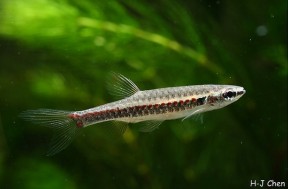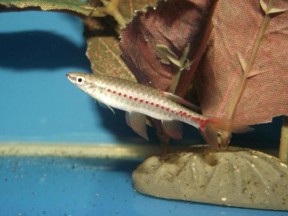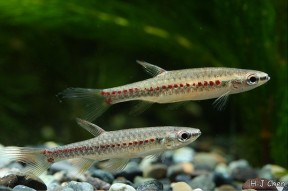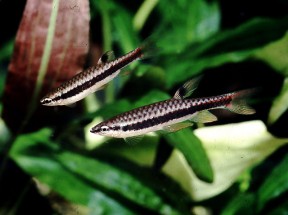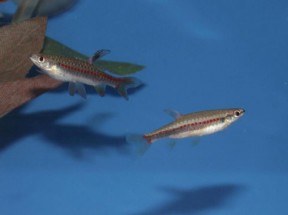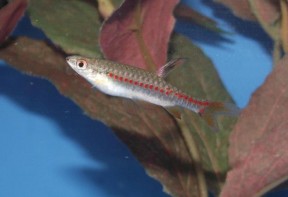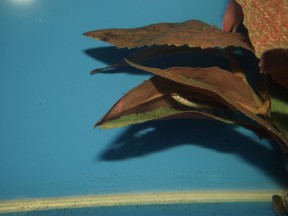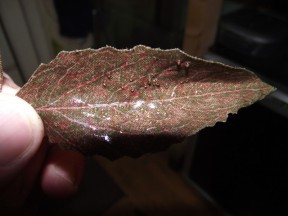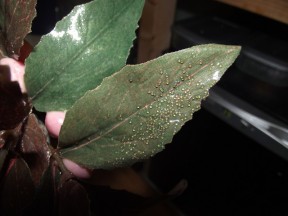Copella nattereri
SynonymsTop ↑
Pyrrhulina nattereri Steindachner, 1876
Etymology
Copella: a diminutive of the generic name Copeina which was named for naturalist Edward Drinker Cope (1840-1897).
nattereri: named for Austrian naturalist Johann Natterer (1787-1843).
Classification
Order: Characiformes Family: Lebiasinidae
Distribution
This species is widespread in the middle and upper Amazon river drainage, including its major tributaries, in Peru and Brazil.
The type series was collected from two localities, namely ‘mouth of the Río Negro’ and ‘Obidos, in a tributary of the Amazon River’, the latter corresponding to a locality in Pará state.
Habitat
Mostly inhabits forest streams and minor tributaries, and often occurs in flooded forests during periods of high water.
Its most-favoured habitats are characterised by large amounts of overhanging riparian vegetation and the water is typically stained the colour of weak tea due to substances released by decomposing organic matter.
Maximum Standard Length
40 – 45 mm.
Aquarium SizeTop ↑
Surface dimensions of 60 ∗ 30 cm or equivalent should be the minimum considered for long-term care although smaller aquaria can be used for breeding.
Maintenance
Best kept in a densely-planted aquarium or paludarium with some overhanging vegetation, roots or branches important if you wish to raise fry alongside the adults (see ‘Reproduction’).
Floating vegetation is also useful since this species appears to prefer relatively dim conditions and spends much of its time in the upper part of the water column.
The addition of dried leaf litter further emphasises the natural feel and as well as offering additional cover for the fish brings with it the growth of microbe colonies as decomposition occurs.
These can provide a valuable secondary food source for fry and the tannins and other chemicals released by the decaying leaves are also considered beneficial for fishes from blackwater environments. Alder cones may also be used for the latter purpose.
The water should be well-oxygenated with a little surface agitation advisable.
Do not add this fish to a biologically immature aquarium as it can be susceptible to swings in water chemistry.
Water Conditions
Temperature: 20 – 28 °C
pH: 4.0 – 7.0
Hardness: 18 – 90 ppm
Diet
Probably a micropredator feeding on tiny invertebrates and other zooplankton in nature.
In the aquarium it will accept dried foods of a suitable size but should also be offered daily meals of small live and frozen fare such as Artemia nauplii, Moina, grindal worm, etc.
Small insects such as crickets or Drosophila fruit flies are also suitable to use although it’s best to fill the stomachs of these by feeding them fish flakes or some kind of vegetable matter before offering them to the fish.
Behaviour and CompatibilityTop ↑
Peaceful but somewhat unsuitable for the general community aquarium.
It’s perhaps best-maintained alongside similarly-sized characids, gasteropelecids, lebiasinids, smaller callichthyid or loricariid catfishes and diminutive, non-predatory cichlids.
Try to buy a mixed-sex group of at least 8-10 specimens, include other schooling fishes to provide security, and you’ll be rewarded with a more natural-looking spectacle.
Males will also display their best colours and some fascinating behaviour as they compete with one other for female attention.
Sexual Dimorphism
Males grows significantly larger, develop more-extended fins and are more intensely-coloured than females, while the latter are noticeably rounder-bodied, especially when gravid.
Nuptial males lose the dark lateral stripe and assume an overall paler colour pattern.
Reproduction
This species deposits its eggs among vegetation, these being guarded by the male during incubation.
In a mature set-up it’s possible that small numbers of fry may start to appear without intervention but should you wish to maximise yield a more controlled approach using a separate tank is preferable.
This can be arranged very simply with an air-powered sponge filter and some aquatic plants or synthetic alternative which should ideally be floating or reaching the water surface.
Nuptial males form small, temporary territories around an intended spawning site and attempt to attract sexually-active females in the vicinity.
The eggs may be laid on a broad plant leaf or if unavailable scattered among fine-leaved vegetation and the female(s) can be removed post-spawning, leaving the male to guard and tend the brood.
Incubation is 36-72 hours and once the eggs begin to hatch parental care ceases and the male should also be removed as he may begin to eat the fry.
Initial food should be Paramecium or a proprietary dry food of sufficiently small (5-50 micron) grade, introducing Artemia nauplii, microworm, etc., once the fry are large enough to accept them.
As with other Copella spp. growth is very slow.
NotesTop ↑
This species is sometimes traded as C. sp. ‘red line’, ‘spotted tetra’ or as its congener C. nigrofasciata.
It looks very similar to C. nigrofasciata but can be told apart by the fact it possesses a maximum of three laterally-orientated rows of red spots on the flanks (vs. five or six rows in C. nigrofasciata).
In the past it’s name was also widely applied to the fish now identified as C. callolepis and C. meinkeni, and this misidentification continues to an extent although the two are easily-distinguished by the fact that C. nattereri is the only one of the three possessing a dark lateral stripe on each side of the body.
The combination of characters diagnosing it from all congeners is as follows: 23-24 scales in the lateral row; presence of a broad, dark lateral stripe extending from the tip of the snout to caudal-fin base with a paler stripe above; a black triangular marking in the ventral rays of the lower caudal-fin lobe; 1-3 laterally-orientated rows of red spots on the body.
The genus Copella can be told apart from the closely-related Pyrrhulina by aspects of head morphology plus possession of only one (vs. two) row of conical teeth in the premaxillary.
The family Lebiasinidae is included in the order Characiformes and sometimes split into the nominal subfamilies Lebiasininae and Pyrrhulininae, though there has not been a major review of the grouping in recent times.
All lebiasinid genera possess a relatively long, elongate body shape with 17-33 scales in the lateral series and laterosensory canal system absent or reduced to 7 scales or less.
Some species have an adipose fin while others do not, and the anal-fin has a relatively short base of 13 scales or less.
In the majority of members males have an enlarged or otherwise well-developed anal-fin used in courtship and spawning.
The frontal/parietal fontanelle is always absent, the cheek well-covered by the orbital and opercular bones, the supraoccipital crest is absent, and the scales of the dorsal body begin over the parietal bones.
Characiformes is among the most diverse orders of freshwater fishes currently including close to 2000 valid species distributed among 19 families.
This tremendous taxonomical and morphological diversity has historically impaired the ability of researchers to resolve their genetic relationships with many genera remaining incertae sedis.
A further limiting factor has been that in many cases exhaustive study of these on an individual basis is the only way to resolve such problems.
Modern molecular phylogenetic techniques have allowed some headway, though, and a research paper by Calcagnotto et al. published in 2005 revealed some interesting hypotheses.
Their results suggest that Lebiasinidae forms a trans-atlantic, monophyletic clade alongside the families Ctenoluciidae and Hepsetidae, this clade further forming a sister group to Alestidae.
Others such as Oliveira et al. (2011) have concluded that the family Erythrinidae is also closely-related to this grouping with Hepsetidae and Alestidae more distant.
References
- Steindachner, F., 1876 - Sitzungsberichte der Kaiserlichen Akademie der Wissenschaften. Mathematisch-Naturwissenschaftliche Classe v. 72 (1. Abth.): 6-24
Beiträge zur Kenntniss der Characinen des Amazonenstromes. - Calcagnotto, D., S. A. Schaefer, and R. DeSalle, 2005 - Molecular Phylogenetics and Evolution 36(1): 135-153
Relationships among characiform fishes inferred from analysis of nuclear and mitochondrial gene sequences. - Reis, R. E., S. O. Kullander and C. J. Ferraris, Jr. (eds.), 2003 - EDIPUCRS, Porto Alegre: i-xi + 1-729
Check list of the freshwater fishes of South and Central America. CLOFFSCA. - Zarske, A., 2011 - Vertebrate Zoology 61(1): 13-45
Beiträge zur Kenntnis der Vertreter der Gattungen Pyrrhulina VALENCIENNES, 1846 und Copella MYERS, 1956 des nordöstlichen Südamerika (Teleostei: Characiformes: Lebiasinidae). - Zarske, A. and J. Géry, 2006 - Zoologische Abhandlungen (Dresden) 56: 15-46
Zur Identität von Copella nattereri (Steindachner, 1876) einschließlich der Beschreibung einer neuen Art (Teleostei: Characiformes: Lebiasinidae).
